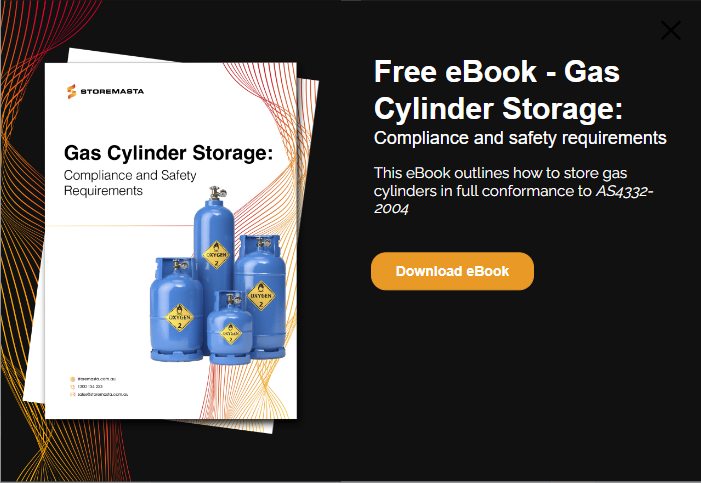AS4332-2004 - The storage and handling of gases in cylinders recommends that wherever possible, compressed gases in cylinders should be stored outside. This blog looks at three hazards which are the primary reasons that gas cylinders stores should be isolated away from the main worksite, buildings, operations and production areas. We’ll also outline additional control measures specified in the Standard to ensure your gas cylinder stores reach 100% safety compliance.
Asphyxiation Hazards
With the exception of oxygen, any leaking gas under pressure is a potential asphyxiation hazard. The air we breathe is made up of 21% oxygen, 78% nitrogen, and 1% mix of other gases. When another gas (not oxygen) is leaked into the atmosphere it will displace the oxygen, and reduce the overall oxygen content in the air. When this happens outside, very often the leaked gas dissipates quickly and the gas percentages in the air remain at safe levels.
But cylinders stored indoors (and especially within confined spaces) present an increased asphyxiation risk as pressurised gas leaking from a cylinder can quickly fill a room. Once oxygen levels in a room fall below 18% anyone entering the area is at high risk of cognitive impairment, collapse, brain damage and death from lack of oxygen.
The standard has a number of requirements that address asphyxiation hazards, these include:
- Regularly checking the cylinders (and their fittings) for leaks
- Protecting cylinders from falls or being knocked over
- Never storing cylinders in basement areas
- Ensuring that safe oxygen levels are maintained whenever cylinder stores are being occupied or accessed by workers. This can be done by either a natural or mechanical ventilation system.
- Training staff and contractors so they fully understand the asphyxiation hazards present at the workplace, how to use breathing apparatus (as necessary), plus what to do in an emergency
IMPORTANT: Gases like LPG which are heavier than air, tend to displace oxygen in low lying areas and along the ground. They take longer to disperse than gases which are lighter than air.
Fire and Explosion Hazards
Any gas cylinder exposed to fire or radiant heat can explode with catastrophic force. Additionally Class 2.1 Flammable Gases and Class 2.2 (5.1) Oxidising Gases can ignite, feed, and cause a fire to burn with more ferocity and intensity. An outdoor cylinder store is especially recommended for flammable and oxidising gases because the natural ventilation helps to keep any leaked gases within explosion limits.
Gas cylinders must be protected at all times from industrial heat and ignition sources, as well as isolated from combustibles. Outdoor cylinder stores are ideal because they can be deliberately situated away from:
- Operating plant, furnaces, radiators, boilers, and other machinery that produce industrial heat
- Refuse, vegetation, and other combustible materials
- Smoking areas, work and production areas that generate sparks, personal electronics and other sources of static electricity
Flammable and oxidising gases isolated in an outdoor cylinder store are also less likely to intensify a fire that breaks out in other another area, and if a fire were to start in the store it will be much easier to contain.
IMPORTANT: The Standard requires that all compressed gases must be kept at least 1 metre from building windows, doors, air vents and ducting. Flammable gas stores require additional signage and warning placards.
Toxic Hazards
When workers are exposed to Class 2.3 Toxic and Corrosive Gases they can die or suffer debilitating injuries. Toxic gases inhaled or ingested are quickly absorbed into the bloodstream, penetrating major organs like the kidneys or lungs as well as the reproductive and nervous systems. Depending on the chemical toxicity of the gas and the intensity of the exposure — workers can suffer acute and immediate injuries (blindness, burns, rashes) or chronic illnesses that develop with repeated exposure (cancer, dermatitis, asthma).
Toxic gases must be isolated from other compressed gases, dangerous goods and hazardous chemicals by at least 3 metres. When cylinder stores are located outside it makes this segregation and isolation easier, and any chemical reactions of dangerous incidents easier to contain.
The Standard requires that:
- All cylinders should be stored upright and protected at all times from knocks or falling over. Cylinders holding Class 2.3 Toxic Gases must also have a gas-tight outlet cap or plug fitted when not in use.
- All gas cylinders are protected from fire and radiant heat
- Gas cylinder store must be fenced off and secured so that unauthorised personnel cannot access the gases
TIP: When handling and storing Class 2.3 Toxic Gases you should also consult Australian Standard AS 4452 The storage and handling of toxic substances.
Next Steps
For more detailed information about how to ensure your cylinder store meets the requirements of Australian Standard AS4332-2004 - The storage and handling of gases in cylinders, please download our free eBook Gas Cylinder Storage: Compliance and safety requirements. We unpack the requirements of the Standard using real-world examples and case studies, helping WHS Managers and Supervisors in charge of managing and storing gas cylinders and other Dangerous Goods. Download it today by clicking on the image below:
Joining the team as a Dangerous Goods Storage Consultant, Melissa Hampton became Storemasta's Marketing Manager in late 2021. With extensive knowledge and experience in chemical compliance, Melissa is responsible for leading the Marketing team and helping shape their marketing strategy. In her spare time, you can find Melissa hiking, swimming and enjoying the great outdoors in beautiful north-west Tasmania.
